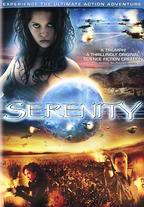ANALYSIS: Serenity
By Writer Unboxed | February 7, 2006 |
 One of the things we like to do is analyze movies for the storytelling structure. Our latest film analysis is the Joss Whedon sci-fi flick, Serenity.
One of the things we like to do is analyze movies for the storytelling structure. Our latest film analysis is the Joss Whedon sci-fi flick, Serenity.
Whedon’s movie is an outgrowth of his t.v. series Firefly. Fox TV abused the show by giving it crappy time slots and showing the episodes out of order before pulling the plug due to bad ratings (Whedon has famously declared he’ll never work with Fox again). The series found a home on the SciFi Network, and the respectful treatment helped it become a cult-classic. Universal acquired the rights to Firefly and greenlighted a feature film based on the series, perhaps the first time in Hollywood history that a movie studio wanted to transform a failed t.v. show into a feature film.
Released in September 2005, the film did ok at the box-office, just enough to recoup the cost of production (source), and now the studio is in talks with the SciFi Network to produce a t.v. film to be shown on SciFi. So Whedon’s vision lives on.
What made Firefly and, by extension, Serenity a story that captured the hearts of millions? We watched the movie to find out, then chatted about it.
Kathleen: One of the things that knocked my socks off was how Whedon used contrasts to flesh out both character and setting so that both are real and believable. Let’s talk about setting first. The success of sci fi storytelling really hinges on world building. I really dug how Whedon juxtaposed a Western over a futuristic world. “Stagecoach in space,” he called it. What did you think of that?
Therese: It was a smart hook; Whedon gave us something familiar to lean on while pushing us into new territory. He also veers from what the viewer’s expectation of the future might be; there’s not a lot of bling and glitz on the fringes of the universe. In fact, aside from a few flashbacks and Mr. Universe’s pad, this is a gray world full of grunge. But it was fascinating grunge. At times the crew’s ship reminded me of Han Solo’s Millennium Falcon, ready to fall apart at any moment. Other aspects of the movie also reminded me of Star Wars (the Alliance and the Reavers were a bit like the Empire and Jabba the Hut’s crew), but the characterization was phenomenal. I especially liked River, the mind-charred reader who inadvertently became privy to the Alliance’s darkest secrets when they programmed/tortured her. How about you? Character faves?
KB: River’s my favorite character, mostly because she IS such a study in contrasts. A waif who becomes a deadly killing machine and can’t control her impulses. I never knew what that character was going to do in any given situation because she was so conflicted: about herself, about her powers of telepathy, about her desire to stay safe even while she brings danger to everyone around her, especially her beloved brother. She was a fascinating psychological mess. As for the Star Wars references, I agree, I think it’s really hard for stories not to be slightly derivative of a major success within the genre. Harry Potter’s going to loom large over YA fantasy; the Lord of the Rings didn’t do Narnia any favors. What did you think about Mal, the main protagonist?
TW: He’s an interesting character because he’s been pushed to the edge of his own humanity, being the sole survivor in his platoon during the big war between the fringe folk and the Alliance. Good inner conflict. One of the sage characters tells him at one point that what he needs more than anything is Belief, and Mal pretty much laughs that off. Because he expects disaster, he pushes himself and his crew (and his mate, Inara) to the absolute edge. But in doing so, he wrings great stuff out of them all.
KB: I like that Mal’s a rebel with an inconvenient conscience. Whedon’s put him in a really bad place physically and emotionally in this movie. He has to rob banks to survive. He kills without thinking about less lethal alternatives first. So when the Shephard (what’s with those cornrows anyway? The stylist should be fired.) character tells him to believe, the character arc is from cynic to believer. It’s a little obvious, but we weren’t beaten over the head with it, imo. Speaking of storytelling devices, what did you think of the antagonist, the Operative?
TW: First of all, aren’t we over choosing black people to always play the villain? That aside, I thought he was a fascinating character. He was so dispassionate about what he had to do! Killing for him was like taking a sip of coffee, you know, a ritual, and nothing to get too excited about. I really liked was the contrasts between him and Mr. Universe. The man who wanted to make everyone the same, who wanted conformity and obedience vs. the man who demanded truth and believed passionately in the power of a single voice. One of the best lines in the movie: They can’t stop a signal. For a secondary character, Mr. Universe had a pretty important role, don’t you think?
KB: I guess I never thought about the fact that the Operative was black, but I see what you mean. It’s like the mania for gay villains a few years back. That got old pretty quick. But I loved what the actor Chiwetel Eiiofor brought to the role, a sort of nobility and purity infusing his insistence on homogenity. I’m sure there’s some samuri significance in the line “you must fall on your sword now”–the Operative’s preferred way of killing–but I’m not up on my asian references. So I feel like I’m missing something there. I also liked Mr. Universe for the same reason you did. I hazard a guess that it’s a commentary on today’s corporate control of the media. Mr. Universe has a multidimensional way to subvert The System, and we do too, in the form of blogging and on-line communications. There. Off the soapbox now. What did you think about the overall plot structure? I thought it mirrored a classic western. Boring or innovative?
TW: I don’t remember any Stetsons in this flick, but let’s see what we had: a beginning w/ post-war frictions, a wild frontier, a jaded guy w/ something to prove, a robbery and a bar fight; a middle that expands on a typical archetypal conflict, where problems evolve from maintaining order, where the jaded guy is taxed by an equally-jaded woman; an ending w/ more violence and suffering, and eventually a satisfying resolution. It is like a western, then again many great flicks have a classic western structure, too, including the previously mentioned Star Wars. This film goes to prove that you can take a classic structure and unbox it by using unique characters and adding color and jagged edges to the black-and-white story sketch. For example, the Reavers were demented former humans. We were appalled by them but also felt sorry for them. The group who made them demented went wrong only in trying to make things peaceful for everyone. Interesting stuff. What did you think?
KB: I agree, it was Screenplay Template 101, but what kept it from banality was the shades of gray in the character’s motivations. Whedon was very careful to balance the good with the bad–and your example of the Reavers was the one I was thinking of too. I think that’s key in any story. Antagonists are more interesting when they have frailties and real emotions, as are protagonists when they show they aren’t one-note sympathetic.
TW: Well, partner, before we wrap this one up, I just have to say that I thoroughly enjoyed Kaylee’s obsession with the good doc, Simon. When they thought they were about to die and Simon admitted his one regret was not going after Kaylee, and Kaylee clarified, “You mean, sex? Hell with this; I’m gonna live!” I was pretty much spitting popcorn. Too funny! You’ve got to write about characters worth rooting for, and Whedon definitely knew how to do this. I enjoyed it!
KB: Me, too. My favorite line was also a Kaylee special, where she said, “I haven’t had anything between my nethers what wasn’t mechanical.” That brought out a belly laugh. A touch of humor always helps sell the character.
How many boxes do we give this movie on a scale of 1-5? ####










nice!
I just stumbled across this blog and I just wanted to say that it is awesome!